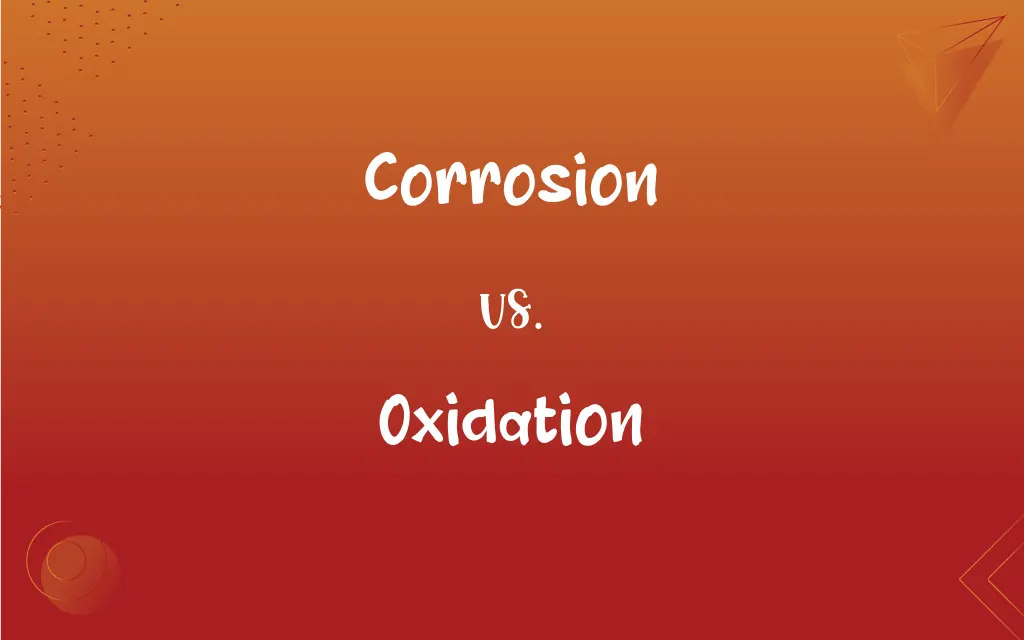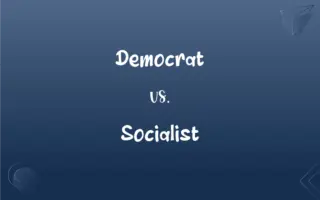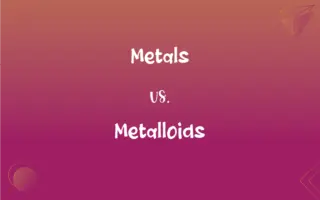Corrosion vs. Oxidation: What's the Difference?
Edited by Janet White || By Harlon Moss || Updated on October 16, 2023
Corrosion is the deterioration of materials by chemical reactions, while oxidation is the loss of electrons or gain of oxygen in a substance.

Key Differences
Corrosion refers to the gradual destruction or degradation of metals and materials, usually due to reactions with their environment. This destructive process typically involves the interaction of the material with environmental factors such as moisture, oxygen, or other chemicals. Corrosion is a natural process, and its rate can vary based on the material and the environment it is exposed to.
Oxidation, on the other hand, is a chemical process where a substance loses electrons, often accompanied by the addition of oxygen or the removal of hydrogen. While oxidation is a broader term that encompasses various chemical reactions, it is commonly associated with the process where metals react with oxygen to form metal oxides. It's essential to note that not all oxidation processes result in corrosion.
Although corrosion often involves oxidation, the two terms are not interchangeable. Corrosion specifically relates to the deterioration of materials, primarily metals, due to environmental reactions. In contrast, oxidation is a more general term that describes a type of chemical reaction, not limited to metals or even to destructive processes.
For instance, rusting is a form of corrosion that metals, especially iron, undergo when they react with oxygen in the presence of moisture. This rusting process is also an oxidation reaction, as the metal loses electrons. However, not all oxidation reactions result in something as visibly detrimental as rust.
In summary, while both corrosion and oxidation are related and can often overlap, they have distinct definitions and implications. Corrosion always denotes a negative and damaging effect on materials, while oxidation simply describes a type of chemical change that can be either beneficial or detrimental.
ADVERTISEMENT
Comparison Chart
Definition
Deterioration of materials by chemical reactions.
Loss of electrons or gain of oxygen in a substance.
Applicability
Primarily metals.
All substances, including metals and non-metals.
Result
Degradation or destruction of material.
Chemical change in the substance.
Examples
Rusting, tarnishing, pitting.
Rusting, combustion, browning of fruit.
Relationship with environment
Involves reactions with the environment.
Not always environment-dependent.
ADVERTISEMENT
Corrosion and Oxidation Definitions
Corrosion
Corrosion results from chemical reactions.
Chemical corrosion of pipes can lead to leaks.
Oxidation
Oxidation can lead to the addition of oxygen.
The oxidation of iron produces iron oxide or rust.
Corrosion
Corrosion is the gradual decay of metals.
The bridge suffered from severe corrosion due to saltwater exposure.
Oxidation
Oxidation can occur in various substances.
The oxidation of apples causes them to turn brown.
Corrosion
Corrosion can affect the structural integrity of materials.
Corrosion weakened the building's steel framework.
Oxidation
Oxidation doesn't always result in corrosion.
The oxidation of glucose provides energy for our cells.
Corrosion
Corrosion often involves oxidation.
Iron corrosion in the presence of moisture results in rust.
Oxidation
Oxidation is a type of redox reaction.
In a battery, oxidation occurs at the anode.
Corrosion
Corrosion's rate can vary based on the environment.
Coastal areas tend to have higher corrosion rates due to salt air.
Oxidation
Oxidation involves the loss of electrons.
The oxidation of sodium results in it giving up an electron.
Corrosion
The act or process of corroding.
Oxidation
The combination of a substance with oxygen.
Corrosion
The condition produced by corroding.
Oxidation
A reaction in which the atoms of an element lose electrons and the valence of the element is correspondingly increased.
Oxidation
The combination of a substance with oxygen.
Oxidation
(chemistry) A reaction in which the atoms of an element lose electrons and the oxidation state of the element increases.
Oxidation
The act or process of oxidizing, or the state or result of being oxidized.
Oxidation
The process of oxidizing; the addition of oxygen to a compound with a loss of electrons; always occurs accompanied by reduction
FAQs
Can non-metals corrode?
While corrosion primarily affects metals, certain non-metals can also degrade in specific conditions.
Is rusting a type of corrosion?
Yes, rusting is a form of corrosion specific to iron and its alloys.
How can corrosion be prevented?
Corrosion can be prevented through coatings, galvanization, and choosing corrosion-resistant materials.
What is corrosion?
Corrosion is the deterioration of materials, usually metals, by chemical reactions with their environment.
What is oxidation?
Oxidation is a chemical process where a substance loses electrons, often with the addition of oxygen or removal of hydrogen.
Does corrosion always result from oxidation?
While many corrosion processes involve oxidation, not all do.
Why do apples turn brown when cut?
Apples turn brown due to the oxidation of phenolic compounds when exposed to air.
Are oxidation and corrosion the same?
No, while corrosion often involves oxidation, they have distinct definitions and implications.
Why does iron corrode easily?
Iron reacts readily with oxygen, especially in the presence of moisture, leading to rust.
What materials are most resistant to corrosion?
Stainless steel, titanium, and certain alloys are known for their corrosion resistance.
What causes corrosion?
Corrosion can result from exposure to air, moisture, chemicals, or other environmental factors.
Is browning of fruit an oxidation process?
Yes, the browning of fruit is a result of oxidation.
Can oxidation be beneficial?
Yes, oxidation can be beneficial, as in energy production in cells.
What's the link between corrosion and metal fatigue?
Corrosion can weaken metals, making them more susceptible to fatigue and failure.
Is oxidation always a slow process?
No, oxidation can be rapid, as in combustion, or slow, as in the rusting of metal.
Are antioxidants related to oxidation?
Yes, antioxidants are compounds that inhibit or prevent oxidation, especially in biological contexts.
Can corrosion be reversed?
While some minor corrosion can be removed, severe corrosion causing material loss is irreversible.
Can oxidation occur without corrosion?
Yes, not all oxidation processes result in corrosion.
Is burning or combustion an oxidation process?
Yes, combustion is a rapid form of oxidation.
Can oxidation occur in a vacuum?
While oxygen is often involved in oxidation, the process can occur without it, so oxidation can happen in a vacuum.
About Author
Written by
Harlon MossHarlon is a seasoned quality moderator and accomplished content writer for Difference Wiki. An alumnus of the prestigious University of California, he earned his degree in Computer Science. Leveraging his academic background, Harlon brings a meticulous and informed perspective to his work, ensuring content accuracy and excellence.
Edited by
Janet WhiteJanet White has been an esteemed writer and blogger for Difference Wiki. Holding a Master's degree in Science and Medical Journalism from the prestigious Boston University, she has consistently demonstrated her expertise and passion for her field. When she's not immersed in her work, Janet relishes her time exercising, delving into a good book, and cherishing moments with friends and family.































































